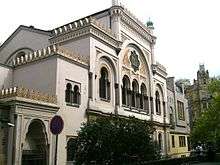Spanish Synagogue (Prague)
| Spanish Synagogue Španělská synagoga | |
|---|---|
 | |
| Basic information | |
| Location | Prague, Czech Republic |
| Geographic coordinates | 50°05′25″N 14°25′15″E / 50.090278°N 14.420833°ECoordinates: 50°05′25″N 14°25′15″E / 50.090278°N 14.420833°E |
| Affiliation | Conservative Judaism[1] |
| Status | Museum |
| Architectural description | |
| Architect(s) | Josef Niklas, Vojtěch Ignác Ullmann |
| Architectural style | Moorish Revival Architecture |
| Completed | 1868 |
The Spanish Synagogue (Hebrew: בית הכנסת הספרדי, Czech: Španělská synagoga, German: Spanische Synagoge) is the newest synagogue in the area of the so-called Jewish Town, yet paradoxically, it was built at the place of the presumably oldest synagogue, Old School (also known as Altshul). The synagogue is built in Moorish Revival Style. Only a little park with a modern statue of famous Prague writer Franz Kafka (by Jaroslav Róna) lies between it and the church of St Spirit. Today, the Spanish Synagogue is administered by the Jewish Museum in Prague.

History
The Spanish Synagogue is not the first synagogue at the site. Before it there stood probably the oldest synagogue in Prague, Old School. In the second half of 19th century, capacity of the Old School did not suffice. The Reform Jewish Community, which used it by the time, therefore decided to demolish the synagogue in 1867 and one year later it was replaced by the new, Spanish Synagogue. Its name presumably refers to the style in which it was built, Moorish Revival style, which was inspired by the art of Arabic period of Spanish history (this name was not always prevalent, in the beginnings it was usually called by German-speaking Jews Geistgasse-Tempel, i. e. Temple in Spirit Street). The architectural plans were designed by Vojtěch Ignác Ullmann and Josef Niklas (an imposing interior decoration).
In 1935, a functionalistic building, designed by Karel Pecánek, was added to the synagogue. Till the Second World War it served to the Jewish Community as a hospital. The synagogue used the space of the new building as well; there was a vestibule and a winter oratory in it. Since 1935, the appearance of the synagogue remained essentially unchanged.
During the Second World War, confiscated properties of Czech Jewish Communities were stored in the synagogue. Ten years after the war, the synagogue was handed over to Jewish Museum and in 1958–1959 it was completely reconstructed inside. In the following year an exposition of synagogue textiles was opened there. Since the 1970s the building was neglected and in 1982 it was definitely closed. The reconstruction started only after the Velvet revolution. Completely restored to its former beauty, the synagogue was opened with a ceremony in 1998.

Appearance
The synagogue itself is two storeys high. Its ground plan is square. The main hall with a dome is surrounded by three built-in balconies. At the south balcony, there is an organ. In the eastern wall there is a great round stained glass window with a central ornament of Magen David (hexagram), installed in 1882–1883. Underneath it there is a monumental aron ha-kodesh. The most impressive decorative element in the synagogue is a gilded and polychromic parquet arabesque. Its designers, Antonín Baum and Bedřich Münzberger, were inspired by Arabic architecture and art. The synagogue was decorated according to their design in 1882–1893. The disposition of the synagogue is reform – the reading platform, bimah, is situated at the eastern wall, not in the central space as in older synagogues. Benches (not original, by the way) stand in rows (as in a church), not around the walls. The aron ha-kodesh, in the style of mihrab, has no curtain (parochet).
Today
Since the last reconstruction in 1998, an exposition about modern Jewish history in the Czech lands can be seen there. It begins with reforms initiated by enlightened Emperor Joseph II which started the Jewish emancipation and inclusion of Jews to major society. Many personalities, which have attributed to its economy, science and culture, are mentioned here. Traumatic events of the 20th century are also commemorated. The themes of modern times accords well with the relation between the synagogue and Reform Jewish Community. The European Cantors Association held the concert for their 11th Annual Convention in the Spanish Synagogue in front of a packed crowd on 19th November 2016. Arranged as a tribute to ECA Convenor, Alex Klein, the concert was led by the Tel Aviv Cantorial Institute Choir conducted by Cantor Naftali Herstik.
See also
- Spanish Synagogue, Venice
References
Literature
- PAŘÍK, Arno, Dana CABANOVÁ a Petr KLIMENT, Pražské synagogy = Prague Synagogues = Prager Synagogen, 2. vydání, Praha: Židovské muzeum v Praze, 2011, s. 87–97.
- Alina HEITLINGER In the Shadows of the Holocaust and Communism:Czech and Slovak Jews Since 1945, Transaction Publishers, New Brunswick, New Jersey, 2006 s.181
External links
| Wikimedia Commons has media related to Spanish Synagogue in Prague. |
Ivan Kalmar. U. of Toronto - The Origin of the "Spanish Synagogue" of Prague, 1999, updated June 2006